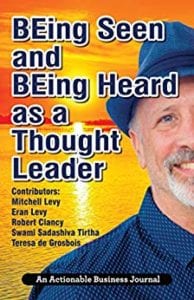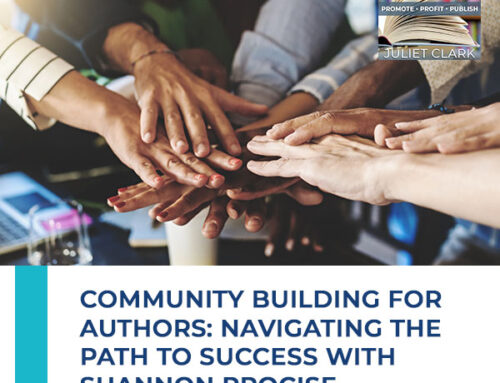
We all have something in us that could benefit others. In the space of thought leadership, when you establish yourself enough, you can become an expert and have people pay for your service. Mitchell Levy, accomplished entrepreneur, adviser, and the AHA guy of AHAthat, takes us into the world of thought leadership: what you need to know and why you should care about it as an expert. Showing two sides of the coin, he shares the different reasons why people do not have success with it and how you can overcome them with good, consistent content.
—
Watch the episode here:
Listen to the podcast here:
Thought Leadership And Becoming An Expert In Your Space with Mitchell Levy
I’m so excited to have the AHA guy joining us. Mitchell Levy is known as the AHA guy who empowers experts, thought leaders and businesses to share their genius. His superpower is extracting the genius from your head in a two-hour interview so that his team can go straight to your book and make you an Amazon bestseller. He is an accomplished entrepreneur who has created over twenty businesses in Silicon Valley, including four publishing companies that have published over 800 books. Mitchell is a TEDx speaker and an international best-selling author with 60 business books. He’s provided strategic consulting to over 100 companies, has advised over 500 CEOs on critical business issues and been the chairman of the board of a NASDAQ-listed company. In addition to these accomplishments, he’s a happily married man for several years and regularly spends four weeks a year in a European country with his family and friends.
Juliet, it’s nice to talk with you and to continue our conversation.
Why did you take a picture? Just put it on Snapchat.
I try to figure out how to use any social media to my advantage. I couldn’t quite figure out how do I use Snapchat. When you go to conferences and you meet somebody you like but you don’t have the ability to do business with them immediately, what I asked them to do is if they want to experiment with me, enjoy my Snap. What happens is when you actually dedicate 30 seconds a day to somebody else and you do it even for seven days in a row, the level of intimacy grows much higher. Your level of trust goes higher. I collect friends at conferences I say, “Do you want to play and Snap together?” I send a picture of the day. I took a picture of us and my Snap was simply, “The first podcast of the morning.” Those that see it say whatever they want to say. It’s showing me in a certain situation, it’s what the younger generation does. I’m doing it for turning people who I like and want to have a business relationship with but we don’t have anything. Keeping them on the radar.
That is so fabulous because what people don’t understand about what we’re going to talk about is that relationships are everything. If you’re caught up in the digital world, you can’t forget to build that one-on-one relationship. I was wondering why you were taking pictures of me. We’re going to talk a little bit about thought leadership. What is thought leadership and why should I care about thought leadership as an expert?
What’s interesting is that word, notion, concept has changed dramatically over time. What I want to do is I want to tell you what a thought leader was five, ten or more years ago and what a thought leader is. We’re 50% in the transition from the industrial age to the social age. In the industrial age, our thought leaders were given to us by the publishers. They were given to us by the broadcast media. They were given to us by the recording studios. We were told who we were going to read. We were told who we were going to see on the big screen, small screen, who was going to be the person delivering the news and what music we are going to listen to.
Many years ago when the proliferation of the web and the internet started becoming commonplace, everyone got a microphone and a camera. What happens is you’re making your own following. You’re not necessarily told by one of the three broadcast studios who the actors are going to be. You get to actually deliver content to an audience and build an audience over time. People who know, like, trust you and subsequently want to do business with you. I use the term thought leadership synonymously where thought leaders synonymously with the term recognize expert. Let’s give you a definition of what is an expert. A simple definition is you provide a service and somebody pays you for it.
The first time somebody pays you, all of a sudden you’re an expert because you’re getting paid for your expertise. If nobody ever pays you again, maybe you weren’t an expert because of word of mouth. If you open up a lemonade store in the corner and people don’t come back on day two, you might as well check the quality of the lemonade. The thing that’s interesting is when you become an expert and people pay you for your services, it is your job to build relationships with a broader audience so they at least know who you are as an expert. You can become recognized as that expert so that when that person in your network realizes they have an issue you could solve, they come and approach you. A recognized expert, a recognized thought leader, the thought leadership you put out there is continually reminding people. It’s not saying, “Look at me.” That’s not how you remind people. Sharing good, compelling content 20% of it you originate yourself, 80% you share from other people and you’re reminding people that this is your space, this is where you play, that you have expertise in that area. That’s thought leadership.
A lot of people out there have not had great success with books and it’s because they’ve been really poor books. They’re wondering why should they write a book and what should they write it on?
There are many different reasons why people don’t have success with books. Let me give you the first one. Regardless of the quality of the book, a book is different than the book in the past. In the past, if you had a publisher who would publish your book, they’re telling you this is the expert in the space. They know they’re going to sell at least 5,000 copies. Their goal is to get to 20,000, 25,000 copies if it’s a business book or get to a couple of hundred thousand if it’s a romance novel or something else. They’re putting a marketing effort and energy in place to push your book on the marketplace and what those authors expected, what they called success was number of sales, number of royalty checks, number of incremental revenues.
When you dedicate 30 seconds a day to somebody else and do it consistently, the level of intimacy grows much higher. Share on XLet’s talk about a book. We live in the world of democratizing book publishing. Anyone who wants to can create a book and it’s easy. What happens is you have to decide the quality of the book that you want to create. You could do it yourself and spend your time or you can have somebody else do it yourself or have someone else do it for you. Create a reasonable quality book, even if it is one of the best quality books you can produce. Whether it’s something that our firm produces, your firm produces or you do it yourself, you have to change your measurement of success. The measurement of success of a book is it’s not how many books sell. Your job as an author is to put the book, which is the best tool you can give somebody to show you’re an expert in your space put the book in the hand of a prospect, who may want to use your service.
Notice I use those words very carefully, put the book in the hand of your prospect. If you’re a consultant, you want the best approach to be successful. If you do it yourself when you’re publishing a book, before the book comes back, order 300 copies and have pre-stamped USPS, FedEx envelopes in place. Have a personal note on the inside, stuff the envelopes when the books come in, do an autographed copy of every book, send them out and do follow up phone calls. If you’re a consultant and I could give you examples of our consultants that have gone from a 40% utilization rate to 80% consistently for years. It’s your job. By the way, those people who do that have books that sell. The more you give, the more you get back. The measurement of success in a book is that you have been hired to do what you’re an expert in. If you craft a book, don’t craft a book with the expectation, I’m going to get great royalty checks from the publisher. That’s a nice plus. We’ve published over 800 books. I write nice royalty checks. That’s a nice plus to our authors in what they’re measuring. How many more speaking gigs did I get? How many more consulting gigs do I get? For those companies, we do customized versions as well.
For companies I’m speaking out or working at, how many customized versions did I create with a publisher that we sent out? How many foreign rights did we close a deal with selling one of our books to China? That’s the measures of success. The first thing that I think about is, “What’s the new client I got?” When you step back and look at what you write in your book, you’re writing a book because as humans, the number one thing we think about is WIIFM, what’s in it for me? You’re writing your book for the WIIFM of your prospect or a better way to say it, I call it CPOP. You’re writing your book for the customer’s point of pain. They recognize, even potentially by looking at the title that you’re an expert solving the areas that they have concerns with, they have issues with.
One thing I hear over and over is, “I don’t have time to write a book.” People get caught in the perfection. They think it’s going to take hours and hours. How did they do this in under eight hours?
We have a unique approach with the AHAthat platform. If you go to AHAThat.com, the platform is free to use, free to share. If you want to share a content on social media, we have 47,000 pieces of content, 47,000 quotes, AHA messages, sound bites, however you want to call it that you can share on social media platforms. There are over 750,000 users who are using the platform because it’s free to use, free to share. If you want content, you can go there. If you go to a page, AHAThat.com/author, we actually show a three-step writing process. That three-step writing process, we’ve had a little over 300 authors write their books in eight hours or less. It is that simple and what we’ve defined as a book is a book has within it 140 bite-sized quotes and seven blog posts. Think of it this way, if you’re standing in front of a crowd and your interest is to capture somebody’s attention, either give them a soundbite that all of a sudden they get or in my case, I give him the title of my book.

BEing Seen and BEing Heard as a Thought Leader: What’s Necessary for Individuals and Businesses to Transition from the Industrial Age to the Social Age
Imagine if I’m sitting in front of a crowd and I get to introduce myself. I stand up and I go, “Mitchell Levy, I’m a global credibility expert. I’m a TEDx speaker and international bestselling author of the book.” I read the title, BEing Seen and BEing Heard as a Thought Leader and then I say, “Thanks. Happy to chat with you if you’re interested.” If you’re sitting in the audience and your CPOP, your point of pain is you want to be seen or be heard or you want to focus on your thought leadership, you might say yourself, “I’m in the room with Mitchell, let me talk to him.” That’s what your book does. That’s how you do it. For us, if you go to AHAThat.com/author, step number one is a four-question document. We put in a Word document and question number one is a very simple question. Let me tell you what it says, “Who is the reader and what are their expectations?” Here’s what it really says, “Who is your prospect? What is their pain point?” That’s what you want to write your book on. What happens is yes you can do it yourself, what a number of our authors have been doing is taking advantage of the fact that we actually were right for them.
Typically, what happens in a five-minute interactive conversation like this is you generate five AHA messages. By the way, that’s an AHA message. In a five-minute interactive conversation, you generate five AHA messages. What’s interesting is when we do the two-hour interview, when I look at my business the only bottleneck is that I’m the primary one doing the interviews. I could do two a day. When we get far busier than that, what I’ll do is create a certification program and I’ve been tagging people who I want to then be those doing the interviews. For me, it’s so much fun. I’ll spend two hours on a telephone conversation. We use a free conference call and what I’ll do is I’ll actually talk to you about your CPOP. Who are your clients? What do you solve? What are their objections? What are some of the things you do? In that conversation, what I’m extracting from your head is your genius. I’m extracting from your head the things that you talk about, the things that you do, the things that are relevant.
We have a number of graduates from the AHAthat writing school that when they actually listen to the conversation, they’re pulling out. If we do a five AHA messages in five minutes, two hours produces 140 they’re pulling out the AHA messages. What I do when I’m talking as I’m listening for those sound bites is I’m listening for the things as some of my social proof friends call, the money shots. I’ll tell you how I was recommended to you. I was talking to somebody and somebody who does an assessment tool, a client of yours and she goes, “Mitchell, I know this person also does publishing but she does an amazing job of using quizzes to both capture people’s attention and getting them into the funnel. You’ve got to talk to her.” That’s your soundbite. That’s your AHA message that you put in the hands or in the mind of one of your customers. It made it very easy not just for somebody to recommend but for me to remember. 140 AHA messages that are in a book, you want to have at least one of those. There should be many more than one that your prospects are going to remember not just now but for months or years going forward.
I want to point out, you said something important there that I want to go back to. You said that your content ratio should be 20/80. I always hear people complain about, “I don’t have time for the content.” You gave them a platform to go and grab that 80% from.
It leads a lot of times people ask me the question, “How do you do social media in five minutes a day?” I’m happy to answer that. You have to imagine that in four months from the time in which we start working together, you have an Amazon bestselling book in hardcover, paperback, PDF, Kindle and also on the AHAthat platform. You’re going to be spending between probably two to five hours to two-hour interview and then review time. We let you press the easy button. Let me give you the easy button on social media. The interesting part, social media have two words, social and media. What happens when people for the first time ever get access to a camera or microphone, they see the word social media and they forget the first word and they see the word media and they go, “Here’s a microphone. Look at me, there’s a camera. I’m cool.” That’s not the right way to get people to want to get to know you, like you or trust you.
The more you give, the more you get back. Share on XWhat happens is you need to think about the word social as part of social media. Let’s do social media in five minutes a day, whether it’s five minutes a day or beyond. I love Pareto. I’ll use the Pareto rule again. Wake up in the morning, spend one minute sharing some good compelling content you found the day before or you found in the morning. If it’s an article you read, you read the New York Times, share the New York Times. I’d go to AHAthat we have 47,000 quotes, share a couple of those. Spend a minute, share something out to the platform you play on. If your prospects are on LinkedIn, don’t worry about sharing on Facebook. Share on LinkedIn, to be clear, then go away. Come back a couple of hours later in the afternoon and spend four minutes. The 80/20 rule, 20% sharing content, 80% when you come back and then touch to people who have touched your content. Here’s what’s interesting in social media, people like our stuff, love our stuff, forward our stuff, comment on our stuff and we ignore them.
Let’s use real-world analogy. You’re sitting in an office, somebody looks at you and they come in and they say, “Hi,” and they go, “You left something on the printer, here it is,” or they bring you a cup of coffee. What happens if you sit there and you’re in your work and they just put it down, they walk away, you never say anything? That happens on day one. They do it again and that happens on day two. They do it again and that happens on day three. Is there a day four? No. People are commenting in your stuff on social media and you’re ignoring them. You’re missing the most important part of social media and that’s being social.
As you’re planning your social media, don’t spend so much time worrying about what you’re going to post, what’s cool, what’s amazing, find stuff that resonates with you because if it resonates with you, it will resonate with the audience that you want to serve. If not, then change what you do for a business. If it resonates with you, it resonates with the audience you want to serve and then make sure you spend time with those people who actually are paying you compliments by touching, liking, forwarding your information to touch them back.
In other words, build a relationship. People forget about that on social media though. They’re like, “I posted, why isn’t anybody buying?” You have to have a relationship there. What do you think are the top five best thought leader practices for people out there? It’s changed over the last year or so.
It’s changed a lot. One of the things I did is a small group. It’s less than 2,000 on LinkedIn, I have a group called Thought Leadership Best Practices. I keep an eye on what’s posted there, what’s working, what people are talking about. Here’s the top five. Number one is what happens when people Google your name? Very simple. If what happens is something you don’t like, then you need to fix it. If I meet somebody, they mentioned their name, they gave me their card and I haven’t bumped into them before, the first thing I’m going to do is Google their name. If I see stuff I don’t like, the card gets thrown in the circular file.

Thought Leadership: The book is the best tool you can give somebody to show you’re an expert in your space.
A mugshot is not a good thing.
It depends. If you’re a coach, helping people who are getting out of prison be successful, a mugshot maybe the perfect thing. Everything in life is relative. If you’re a credibility coach and you’re supposed to be squeaky clean, then maybe a mugshot or lawsuits are not good things. What happens, social media companies have spent hundreds of millions of dollars to make sure that your name on their platform comes up. Let’s say you have a Facebook account, but you haven’t touched it in three years and you’re supposed to be good at what you do but I see the Facebook account and you haven’t touched it for a while and you’re a social media expert, I would not once again. Number one, Google your name and see what happens. The second is what we talked about in social media and five minutes a day consistently share content. You could play with a platform that’s fun because you want to do something that’s a little bit more social.
There’s nothing wrong with that but the platform you play with when I say it in that way is the platform where your prospects hang out. You want to consistently share content. Make sure you do a good job of getting back to people and interacting with them, being social and building relationships. That’s number two, consistently share. Number three is, as you can imagine, write a book. The most compelling piece, even with the democratization of thought leadership is when you write a book. I have on my business card at the bottom of the card, it says international bestselling author. 25% of the people I give the card to who don’t know me, that’s where they put their eyes. They light up and they asked me what book. I’ve written 62 books. If I’ve done a good job of building the relationship before I give them my card, I already know a little bit about them. I’ll bring up the book that’s relevant to them because that’s how you build relationships.
A guy spoke at an event, I loved what he was doing. Somebody in the audience said, “That’s a movement I want to start.” We have a book called, Go Ahead, Start A Movement. “I’m in, count me in a movement, let me send you a copy of the book, Go Ahead, Start A Movement.” That was not even my book. That’s the other thing you get familiar with good compelling content, whether you send them an eBook, something else or send them a physical book, that’s another way to build a relationship. That’s number three. As we talked about, there’s an easy button to have your book. If that’s not in plans, it should be. Number four is to create your own thought leadership channel. This is a good example of that, you could do Blog Talk Radio, you could do a consistent YouTube channel, whatever it is that you could write for a media like Entrepreneur, Thrive, Arianna Huffington’s post. You want to have a consistent way in which you’re sharing your thought leadership.
The real benefit of something like this is if you are doing it well-enough, it’s consistent enough, you’re getting enough of an audience, what’s interesting and this is what many people don’t think about, is who do you have on your show? You have an opportunity to go and talk to anyone in the world. I was on 150 podcasts. 40% of them, I didn’t get to speak to the person until we were on the air. That is doing a disservice to their audience. They don’t know who I am. They pronounced my name wrong. They’re putting me at a bad position before we start. I try to make people feel good and paint them right and then they don’t follow through afterwards. If you’re in a show, you’re inviting people who are customers, people who are prospects, people who are partners. You’re inviting people on your show that you want to build a relationship with. If you’re building a thought leadership channel make sure you’re doing it because you do here for the right reason.
If something resonates with you, it'll resonate with the audience that you want to serve. Share on XLet’s do number five. Number five is the most unique one and that is you build a best of list. It’s the top ten people who are producing quizzes in the United States or the top 25 social media people who are in this vertical. Think about what you’re doing in this case, the first thing that you create a graphic image that says you’re a part of the top 25 or top 50. What you’re doing is you’re figuring out who the influencers are in the space you play and you’re crowning them that they hit the top. You’re giving them an opportunity to brag. They’re bragging about you getting the award that you’ve given them and they’re bragging about themselves. You’re increasing your social media. Once again like number four, you use it as an opportunity to build a relationship with those influencers who are part of your space.
How can you take one piece of content and turn it into five or ten platforms? I know a lot of people don’t know how to repurpose what they’ve done. When they talk about that they don’t have enough content, they don’t think about this. They say, “I don’t have enough time but they’ve got this content that can be repurposed.” You are doing a book with 140 pieces of content in it. How can they take that, expand and use that?
When I was doing number four, creating my thought leadership channel, I wanted to meet people in the industry and to actually demonstrate how to repurpose content. I have a platform called Thought Leader Life. The blueprint is to show you exactly what we do and what’s interesting is we do a Zoom call. Typically when I do a Zoom call, I am doing a Facebook Live as well. We’re streaming live on Facebook because then people can comment and see it. What happens over time is Facebook’s done a good job of having a number of views happen as well. We then take off the video and we upload it to YouTube. We then strip out the audio and we put it on iTunes. We put it into a couple of different channels, including For Immediate Release, which is Shel Holtz’ channel. That goes to iTunes, Stitcher and a couple of other places. What happens is based on the interview, we do a blog post.
Out of every 30-minute conversation, we pull somewhere between 40 or 50 AHA messages. What I did at the beginning is, I don’t want to say randomly, but I pick four or five shows and I create an AHA book because of 40, 50 AHA messages. An AHA book has 140 so I’d pick four or five shows. What I started doing is grabbing a cohost for the month. We would do five shows together. I do one with Natalie and then four with guests. What’s interesting is we would produce for a month and basically four to five hours of the cohost’s time we produce five videos, six blog posts because you have a summary blog post and an AHA book. It’s interesting to take the same piece of content and put it into different formats and share them in different ways. What’s interesting, what people often think about is, “I did a show like this. I did it once and I shared it on Facebook and that’s where my audience is and I’m done.”
The person who you may want to reach it may not be watching or may not be paying attention. If they do a tweet, they’re not there at that point in time. You want to share what you’ve done a couple of different times, a couple of different platforms and even come back to it a couple of weeks later and re-talk about it. It depends, if your audience complains then you got to make sure you share in the right place. Generally speaking, they’re going to thank you for sharing something that they thought was valuable. That’s how you take it a single piece of content and turn it on multiple platforms and share it in multiple different formats.

Thought Leadership: The catchphrase is: “I have no competitors; only potential partners.”
That’s what we do as well, we have it all over the place. You have something you want to give to us before I let you go?
If you’re interested in talking about your book, who you are and what would be the appropriate thing for you, we normally charge for a half-hour strategy session. I’m happy to have people actually go and spend time with me on that. If you go to MitchellLevy360.com, I’ve listed my social media sites and a link to book time with me and will let you connect to the sites that are relevant to you. Also find a half-hour on my calendar in a time that it works for you. I don’t sell, we’ll do a strategy session. A strategy session is, does it make sense for you now? I am as happy to say no, it doesn’t make sense for you now or direct you somewhere else as I am to say yes.
I want to make sure that when I talk to somebody that when they’re done, their feeling is, “Mitchell listened to me, he saw me and gave me advice that I am now implementing.” It doesn’t matter if it’s buying my products, services or buying a partner’s products, services or changing the industry. I try to be careful about that but I do it with my heart and not with my head. I’m doing it with the person on the other end, making sure that we are focused on. Let me do it that way and if the link’s not right there, connect me and say, “Mitchell, I need to set up time. Send me the link.” It should be MitchellLevy360.com.
Everything in life is relative. Share on XThank you so much. It was proof positive for people that people in the same industry can collaborate in a very nice way. In some ways, we are a little bit competitors but we different things as well. That’s important for people to understand.
I’m from Silicon Valley and you’ll always have competitors. If you actually say to somebody who’s investing to you, they say, “Who are your competitors?” and you say, “I don’t have any,” that’s the telltale sign that they’re going to run away. You need to know who you’re playing with, what’s going on, what’s happening in the space, how you position yourself in relation to everyone else? Yes, you have competitors that said, here’s a phrase I’d like you to remember, “I have no competitors. I only have potential partners.”
I have a lot of potential collaborators, partners. Thank you for that.
My pleasure. It’s great to chat with you.
Important Links:
- Mitchell Levy
- AHAThat.com
- AHAThat.com/author
- TEDx – Mitchell Levy
- BEing Seen and BEing Heard as a Thought Leader
- Thought Leadership Best Practices
- Go Ahead, Start A Movement
- Thrive
- Thought Leader Life
- For Immediate Release
- For Immediate Release on iTunes
- For Immediate Release on Stitcher
- MitchellLevy360.com
About Mitchell Levy

Mitchell Levy (pronounced Lee Vee) is The AHA Guy at AHAthat (https://AHAthat.com) who empowers experts, thought leaders, and businesses to share their genius. His superpower is extracting the genius from your head in a two-hour interview so that his team can ghostwrite your book and make you an Amazon bestselling author.
He is an accomplished Entrepreneur who has created twenty businesses in Silicon Valley including four publishing companies that have published over 800 books. Mitchell is a TEDx speaker and international bestselling author with sixty business books. He’s provided strategic consulting to over one hundred companies, has advised over five hundred CEOs on critical business issues and has been chairman of the board of a NASDAQ-listed company. In addition to these accomplishments, he’s been happily married for twenty-nine years and regularly spends four weeks annually in a European country with his family and friends.
For 20-30-minute shows, he would propose these questions (or whatever you’d like to discuss):
- What is thought leadership and why should I care?
- Why should I write a book and what should I write it on?
- How can I write a book in eight hours or less?
- Should I write a book myself or bring on a ghostwriter? Isn’t that expensive?
For longer shows, you can also add these questions:
- How can I effectively do social media in only five minutes a day?
- What are the top five thought leadership best practices today?
- How can you take one piece of content and turn it into five on ten platforms?
29-Min Webinar on WHY we should ghostwrite your book: http://aha.pub/mitchell-webinar
Additional info:
- TED talk (BEing Seen and BEing Heard as a Thought Leader): http://aha.pub/TEDtalk
- Images: http://MitchellLevy.com/Media
- Books authored: https://Pinterest.com/THiNKaha/Books-by-Mitchell-Levy/
- Free content to share from a Social media enabled eBook platform: https://AHAthat.com
- 3-step writing process: https://AHAthat.com/Author
Connect to Mitchell at: Speaking site: MitchellLevy.com
- AHAthat: AHAthat.com
- LinkedIn: Linkedin.com/in/MitchellLevy
- Facebook: Facebook.com/HappyAbout
- Twitter: Twitter.com/HappyAbout
- Google+: Plus.Google.com/+MitchellLevy
- Pinterest: Pinterest.com/THiNKaha
- Instagram: Instagram.com/Mitchell.Levy/
- Consulting site: THiNKaha.com
LinkedIn Thought Leadership Best Practices
- Group: aha.pub/t-l-b-p
- Thought Leader Life: ThoughtLeaderLife.com
- Book him: seher.tariq@thinkaha.com
Communicate directly after booking him:
Love the show? Subscribe, rate, review, and share!









Leave A Comment